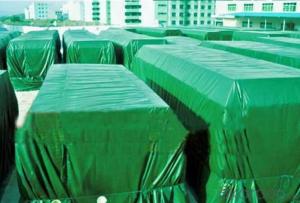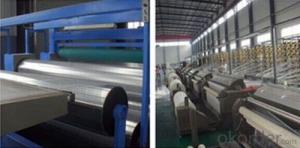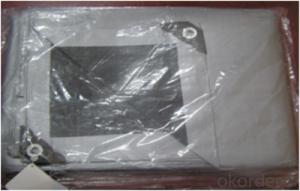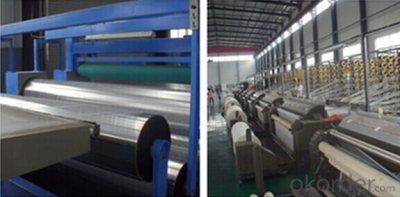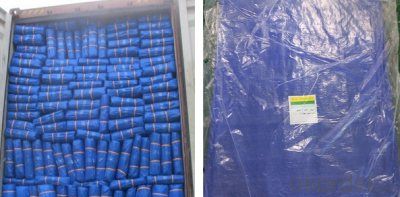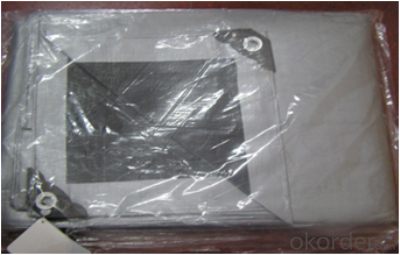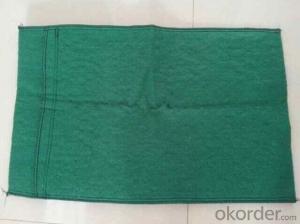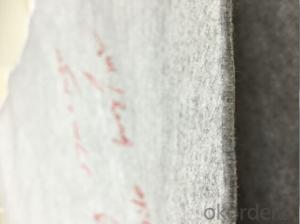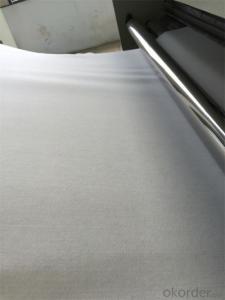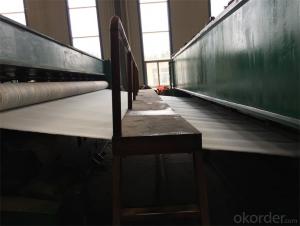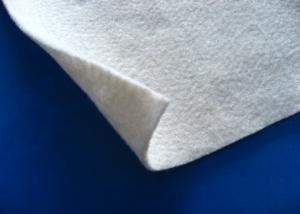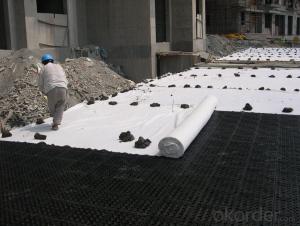Membrane Géotextile Canac Poly Tarps UV Protection Factory 4*4,5*5,6*6,7*7,8*8,9*9,10*10,11*12,14*15
- Loading Port:
- Qingdao
- Payment Terms:
- TT OR LC
- Min Order Qty:
- 0.5
- Supply Capability:
- 12 m.t./month
OKorder Service Pledge
OKorder Financial Service
You Might Also Like
1. Descriptions for Poly Tarps
Product | pe tarpaulin of different usage |
Material | PE material |
Mesh | 4*4,5*5,6*6,7*7,8*8,9*9,10*10,11*12,14*15 etc. |
Weight | 50-300gsm |
Color | blue, silver,green, orange, white, dark blue, dark green and etc |
Size | according to customer's requirment, we have machine for heat-seal |
Coating | Laminated both sides |
Making | rope reinforced hem,heat sealed edges, every eyelet interval three feet or one meter, corners reinforced with triangle plastic sheets |
Features | waterproof, sun-resistant, anti-aging, anti-freeze and also can be Uv treated |
Usage | covering, trucks, boats, camping, farm equipment, tents, construction site etc |
2.Special Treatment
Different sizes and colors are available
Tear-resistant super durability minimized breakage during transportation and storage
Water-resistant and washable: it prevents contamination or damage from rain or moisture
Double waterproof surface.
Reinforced corners.
UV stabilized and sunproof
3. Specifications for Poly Tarps
Product | PE PVC Tarpaulin |
Material | HDPE,LDPE |
Weight | 65-250gsm |
Width | 1.83m,2m,2.44m,3.66m or 4m,available for wider fabric by heat sealing. Or as the customers requirement |
Size | Any sizes by the customers requirement |
Color | double green, double blue, double orange, blue-orange, blue-silver, green-silver, blue,white,red stripe and so on,any color as the customers requirement |
Making | Rope reinforced hem , heat sealed edges, every eyelet interval three feet or one meter ,corner reinforced with or without triangle plastic sheets as customers requirement. |
Features | sun-resistant,UV treated, lightweight, easy to fold, durable and other characteristics. |
Use | Tarpaulin is widely used for truck canopy,ship cover and cargo storage or transportation in mineral factories and ports, also can be used as tents in outside travel and calamities.The tarpaulin is to cover and protect the goods in the open air and avoid the goods get wet. |
Package | Packed in roll or in bales or cartons |
Delivery time | According to the quantity you want.Usually 15-30 days. |
Place of Origin: Shantou, China (Mainland) | Brand Name: TeeZoon | Model Number: as the customer’s request |
Produdct: PE tarpaulin | Product Type: PE fabric | Coated Type: PE laminated |
Color: | Use: truck cover | Weight: 150 gsm |
Technics: Woven | Width: 2m | Pattern: Coated |
Density: 12X12 |
4.Photos for Poly Tarps
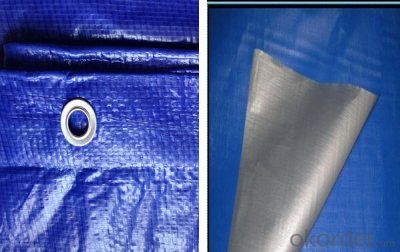
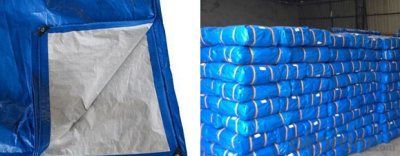
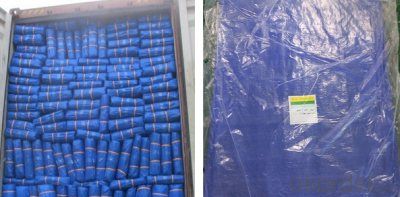
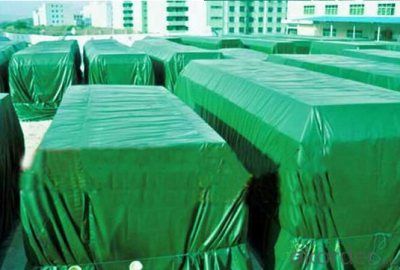
- Q: How do geotextiles help with reinforcement of geogrid retaining walls?
- Geotextiles help with the reinforcement of geogrid retaining walls by acting as a separator between the backfill materials and the geogrids. They prevent the fine particles in the backfill from clogging the geogrids, maintaining their effective functioning. Additionally, geotextiles distribute the load evenly across the geogrids, enhancing their strength and stability.
- Q: What are the applications of geotextiles in geotechnical engineering?
- Geotextiles have a wide range of applications in geotechnical engineering. They are commonly used for soil stabilization, erosion control, and drainage systems. Geotextiles can be used to reinforce soil, preventing slope failures and improving the stability of embankments and retaining walls. They also serve as a barrier against soil erosion by maintaining the integrity of the soil structure. In addition, geotextiles are used for filtration and separation purposes, allowing water to pass through while preventing the movement of fine particles. Overall, geotextiles play a crucial role in enhancing the performance and longevity of various geotechnical structures.
- Q: What are the considerations for geotextile selection in railroad projects?
- When selecting geotextiles for railroad projects, several considerations should be taken into account. Firstly, the geotextile's strength and durability are crucial factors, as it needs to withstand the heavy loads and repetitive stresses of trains passing over it. Additionally, the geotextile's filtration properties are important to prevent soil erosion and maintain proper drainage. The material's resistance to UV degradation and chemical exposure is also significant for long-term performance. Lastly, the geotextile's installation and maintenance requirements, as well as its cost-effectiveness, should be considered to ensure a successful and economical railroad project.
- Q: What are the different geotextile installation equipment and tools?
- Some of the different geotextile installation equipment and tools include geotextile dispensers, spreaders, rollers, staplers, and anchors. These tools are used to ensure proper placement and securement of geotextiles in various construction and environmental applications.
- Q: Are geotextiles commonly used in sports field applications?
- Yes, geotextiles are commonly used in sports field applications. They are used to stabilize the soil, control erosion, and improve drainage in sports fields. Geotextiles help to enhance the performance and longevity of the field, making them a popular choice in sports field construction and maintenance.
- Q: What are the key factors affecting the interface friction of geotextiles?
- The key factors affecting the interface friction of geotextiles include the type of soil or material they come into contact with, the surface roughness of the geotextile and the adjacent material, the normal stress or pressure applied to the interface, and the moisture content of the soil or material.
- Q: How to determine the nominal breaking strength of filament spunbonded nonwoven geotextile
- You can use a dedicated geotextile strong test machine detected.
- Q: What are the key factors affecting the clogging behavior of geotextiles?
- The key factors affecting the clogging behavior of geotextiles include the type and size of particles in the soil or water, the flow rate, the duration of exposure, and the properties of the geotextile itself such as pore size, density, and surface roughness. Other factors may include the presence of chemicals or organic matter in the soil or water, as well as environmental conditions such as temperature and moisture content.
- Q: How do geotextiles help with subgrade separation in pavement systems?
- Geotextiles help with subgrade separation in pavement systems by acting as a barrier between the subgrade soil and the aggregate base. They prevent the mixing of these two materials, which can lead to the weakening of the pavement structure. Geotextiles also aid in reducing water infiltration into the subgrade, preventing its saturation and potential damage. Additionally, they enhance the stability and load-bearing capacity of the pavement system by distributing the applied loads more evenly across the subgrade.
- Q: How are geotextiles affected by mechanical stress?
- Geotextiles are affected by mechanical stress in several ways. Firstly, when subjected to heavy loads or forces, they can experience deformation or stretching, potentially leading to loss of their intended functions. Additionally, mechanical stress can cause geotextiles to fray or tear, compromising their durability and structural integrity. Therefore, it is crucial to select and design geotextiles that can withstand the anticipated mechanical stresses in their intended applications.
Send your message to us
Membrane Géotextile Canac Poly Tarps UV Protection Factory 4*4,5*5,6*6,7*7,8*8,9*9,10*10,11*12,14*15
- Loading Port:
- Qingdao
- Payment Terms:
- TT OR LC
- Min Order Qty:
- 0.5
- Supply Capability:
- 12 m.t./month
OKorder Service Pledge
OKorder Financial Service
Similar products
Hot products
Hot Searches
Related keywords
